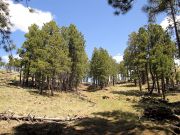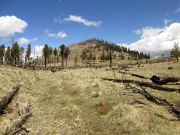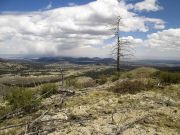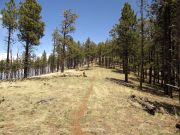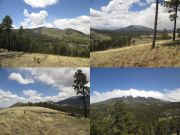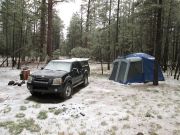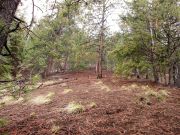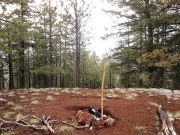
The Mountains of Arizona
www.surgent.net |
|
White Horse Hills HP • Walker Lake Crater • Wing Mountain Today's episode is brought to you by the letter W. This weekend, my wife and I encamped in the high country northwest of Humphreys Peak, expecting a weekend of cool temperatures and sunny skies, as it usually is this time of year. Instead, we got hit by a late-Spring snow and hail storm, which made things interesting and cold. I hiked three peaks, all starting with the letter W — White Horse Hills Highpoint, Walker Lake Crater, and Wing Mountain. The first two I hiked on Saturday while the weather was still decent. I hiked Wing Mountain the next day in gloomy conditions.
Date: May 22, 2015
• Elevation: 9,065 feet
• Prominence: 575 feet
• Distance: 1 mile
• Time: 45 minutes
• Gain: 560 feet
• Conditions: Sunny with cloud build-up, distant virga and strong winds
Arizona
•
Main
•
PB
•
Interactive map
The White Horse Hills appear to be a cooled collection of magma blobs (laccoliths) on the northwest slopes of Humphreys Peak. The summit of this small set of hills reaches 9,065 feet. The hills are mostly barren of trees, from a fire in the 1990s. Sections of burned husks still stand, others lie in heaps on the ground, and a few small copses of living trees in isolated pockets. My wife and I were camping in the area, and I wanted to tag this summit and that of nearby Hochderffer Hills, giving me two 9,000-foot summits.
We arrived the day before, about 4 p.m., and drove in along Forest Road 151, then FR-418. This latter road inches upward to about 8,500 feet in elevation, on the south slopes of the White Horse Hills. We were looking for a place to camp, but there weren't many attractive options right here in the immediate area. There are private homesteads on the south side of the road, and the winds were blowing hard here. We backtracked south along FR-151 and found a secluded spot along a lesser forest road leading to "Little Spring". I set up the tent, and we had a relaxing night at camp.
I was in no hurry to get moving the next morning. I wandered around camp and the roads and let the sun come up to warm us some more. Even at 8 a.m., the sky was full of puffy clouds, and the tops of the ponderosa pines swayed in the steady winds, although were were sheltered from these winds. I set Beth up in our big tent, and left for my hikes at 11 a.m., arriving to the base of White Horse Hills a few minutes later. I parked in a small pullout near where an old Jeep track heads north. This road is now closed to vehicles, but open to hikers.
I hiked up the track to a ridge, about a 150-foot gain. Immediately ahead was the peak. Between the ridge and the peak was a scape of downed trees from a burn about twenty years ago. The road petered out amid the downed trees, but hiking by sight was easy, and soon, I found the continuation of the track, aiming for a saddle to the peak's east. Once here, I went left and found another rotten road snaking up the peak. I followed it until the deadfall was too much to manage. I left the road and went directly upslope to the top, arriving after just 20 minutes.
While the hike wasn't an epic, the views from the top were. Humphreys Peak rose to the south, its highest slopes and ridges still covered in snow, and puffy clouds collecting around its summit. Looking south, west and north, I could see the Hochderffer Hills, Kendrick Peak, Saddle Mountain, a bunch of lower cinder hills, and horizons stretching to the Grand Canyon and the Navajo Nation.
I lingered on the summit for about 10 minutes, taking photos and signing into the summit log. Not many people hike this little peak. It's easy, but it's just not that much of a draw, being surrounded by so many bigger peaks. Nevertheless, it is a worthy little hike. It certainly doesn't demand too much time.
The weather was mixed. The day was sunny, but the clouds moved through quickly and the winds were quite strong, gusting to about 50 m.p.h.. Way to the west, the sky was steely gray with no blue, suggesting an organized front, not just a bunch of random clouds. I could see sheets of virga from the clouds, too.
The descent went fast, and I was back to my truck after 15 minutes. Now, I headed a couple miles west to try my luck with the Hochderffer Hills. However, the road I wanted, FR-151S, was gated closed on the north end. I decided to drive back a mile and hike nearby Walker Lake Crater.
In 2021, Matthias and I returned to climb the northern peak, Peak 8842.
Elevation: 8,511 feet
• Prominence: 381 feet
• Distance: 1 miles
• Time: 45 minutes
• Gain: 380 feet
• Conditions: Sunny but cloudy and gale-force winds
• Peak 8802 statistics: 600 feet of gain, 1 mile round trip
PB
This hill has no name. It's a small cinder hill with a crater, in which sits Walker Lake, hence its unofficial name. In Arizona, lakes are often just moist sumps of land, and this is true here. There's no blue body of water with docks and sailboats. The actual water seems to be confined to one tiny section of the sump, and by summer, it will be gone.
This hill is north of Forest Roads 151 and 461, west of White Horse Hills and north of the Hochderffer Hills, both primary goals for today's outing. I had a map of this hill with me, too, but did not make it a priority. After my hike over in the White Horse Hills, I drove west to get close to the Hochferffer Hills, but found the road I wanted was gated shut. As I drove back, I looked over at the nicely-shaped hill for Peak 8511, and decided to hike it after all. The top seemed to be open, as I really didn't want a heavily-forested summit.
From the junction of Forest Roads 151 and 461, I went east on FR-461 for about a hundred yards, then north on FR-9007-S a quarter-mile to a lovely turn-around and camping area. Here, a lesser road bent right (east), shown correctly on the map. The road looked pretty bad, so I parked and walked from here. I was on this road for just a few minutes. It loses distinction in the trees, but quickly, intersects a much better road that apparently comes in from farther east, but not sure where (the map shows this road to "end" a little to the east). I angled left and started up the rest of the road, pitched at an easy grade, to where it gained the south rim of this crater. From my truck, I had walked a little over a half mile and gained about 120 feet.
The road continues down and loops around Walker Lake. Instead, I left the road and walked up the open slopes, catching a good trail. I was on the summit in moments, the one-way stroll taking about 20 minutes. The top is elongated and hard to tell where the true tip-top is located. I walked the rim a little ways to ensure I hadn't missed anything, but also for some photographs. Everything was lovely — except for the wind. On White Hills an hour earlier, the wind had been stiff but manageable. Here, it was sustaining at 40-50 m.p.h.. It was all I could to to keep my hat on, plus I was chilled quickly. I didn't spend much time here. The views are very nice.
The hike down took about 15 minutes, and from here, I drove back to camp, intending to take a small break, then try other routes in toward the Hochderffer Hills summit. Our camp was located in a small valley hemmed in on the west by FR-151 and the east slopes of the Hochderffer Hills. However, I wanted to explore one other road option first.
About 2 p.m., I set out again, driving south on FR-151 a couple miles. The road I wanted, FR-151-S, is a loop. It's northern end was gated closed as mentioned earlier. The south end was also gated closed too, as I discovered. I decided to return to camp and try Plan C, which was a direct hike from camp. I would need to gain steeply about 600 vertical feet to the ridges, then from there, about a mile to the top. It looked like it would work.
Getting up the 600 feet was easy, albeit tiring. Soon, I was on Peak 8802, the eastern-most peak of these hills. I was hoping that the forest would thin up here, as it seems to do on most of these hills, but it did not. On the ridge, the trees were very thick and I had trouble eye-balling the lay of the land. I hiked another quarter-mile west, still about a half-mile from the top. The winds were howling! I decided to bail, and come back another time. The FR-151-S option is still the best, but it appears it's only open for walking.
As I returned to camp, I realized I was getting these little white flecks landing on me. The sky above me was clear, so I assumed it was pollen of some sort, but no, it was snow, believe it or not. It was actually little hail pellets, or graupel. The clouds were moving in and the weather had taken a turn for the worse in the last couple of hours.
Back at camp, I relaxed in a camp chair. The tiny hail flecks continued to drift down, progressing into a true hailstorm. The pellets were tiny, not big enough to hurt or break a window. The skies above were dark and ominous. We decided to break camp here and drive down in elevation, fearing that we may get stuck here an extra day or two if any of this snow/hail actually accumulates.
It took me about 30 minutes to disassemble the big tent and get everything packed. We drove south about 15 miles and went west on Forest Road 222, nearby Wing Mountain. We found a good spot and set up camp here for the night. The conditions here were gentler: no precipitation and virtually no winds. I got the tent erected, crawled in for a nap, and awoke a couple hours later to thunderstorm cells and a hail-&-snow storm!
Date: May 23, 2015
• Elevation: 8,578 feet
• Prominence: 968 feet
• Distance: 1.5 miles
• Time: 80 minutes
• Gain: 980 feet
• Conditions: Cold and extremely overcast
I awoke an hour later (now about 6 p.m.) to a pattering sound, assuming it to be rain, but when I looked outside, it was more hail. B. was in the truck's cab, curled up in her blankets with her magazines. We weren't about to break camp again. The storms had developed more strongly, including plenty of lightning and thunder. This was more like weather one would expect in August, not in usually-dry late May. I sat up front with B. in the truck. The hail did not let up for another three hours. At about 9 p.m., I went outside to see stars and the waxing crescent moon. But it was very cold, the hail having collected to about an inch deep, and covering the truck in a sheet of "haily" ice.
We both slept well that night, conditions having calmed since yesterday's storms. The next morning, some of the hail pellets had melted, but the air temperature was still below freezing with low clouds. I spent awhile disassembling camp. The tent itself was filthy with mud and I had little choice but to bunch it all up and cram it into the truck. I'd worry about cleaning it and drying it later.
In spite of the conditions, we were having a good time. The weather and the hail were certainly surprising and a little inconvenient, but we were also amused by these events, too. Thus, with low clouds, muddy ground, fog and cold weather, I still thought it was a good idea to climb nearby Wing Mountain. From camp, we drove a couple miles west, the mountain hidden in the clouds. I drove in on a lesser Forest Road that the map indicated to end somwhere on the peak's northeast slopes. I parked, got my pack on, kissed B., and started up the rest of the road, the time about 9 a.m.
I followed the road not much farther, as it simply ended in the trees. I came upon a trail that looked more like a ditch, but it looked promising, so I followed it for about 300 yards. When it started to steeply descend, I decided to leave the trail and start directly up the slopes.
I walked up the slope to a fence, crossed it, then started the upward grind. I was on an obvious "ridge", the peak being surrounded by dozens of these equally-sized ridges formed through erosion. I knew going up would be cake, but I wanted to be sure to descend the same way. I had some margin for error, as any descent route would eventually lead back out to a road, but I didn't want to be that cavalier, as that kind of thinking has gotten me into trouble before.
The slopes were heavily forested with ponderosa, and other trees, but undergrowth was very light, mostly just the bare ground itself. I ascended slowly, building small cairns or jamming sticks into the ground at right angles to serve as a guide for the way down. This went well, and after about 45 minutes, had arrived onto the summit. In these conditions, there wasn't much to see, and even in clear weather, the top is forested with no views. I tagged a couple rocks and snapped a couple images, then started back down.
I was able to follow my path of sticks and cairns easily, descending back to my truck in just 20 minutes. I changed into less muddy clothes and after a few minutes, we started our drive home, arriving a couple hours later.
Given the way circumstances dictated our movements, I was happy to tag the top of Wing Mountain given I hadn't planned on it this weekend. The cold conditions probably helped, as it would be a much sweatier hike even in average conditions. I wouldn't endorse this peak as a must-do while in the area, but if you're like me and have climbed most everything else interesting up here, this is a good peak to get some exercise on.
|
|

